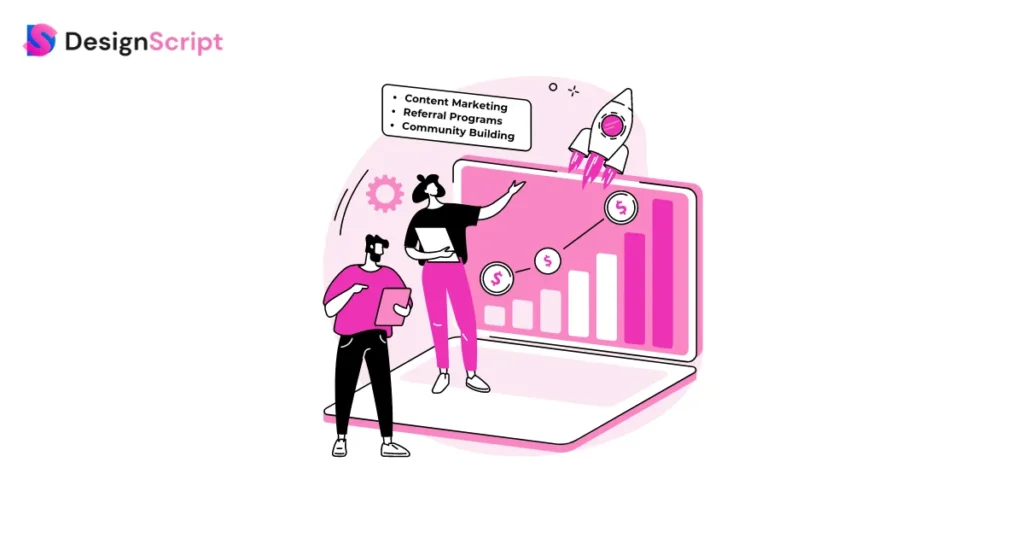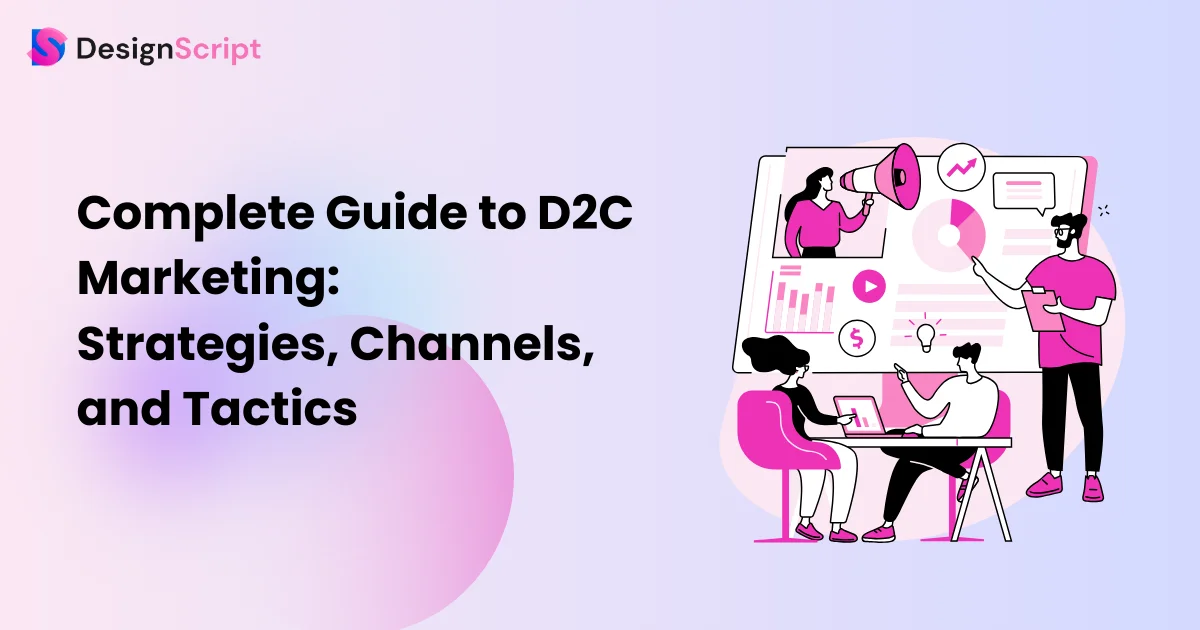Complete Guide to D2C Marketing: Strategies, Channels, and Tactics
In the ever-evolving realm of eCommerce, Direct-to-Consumer (D2C) marketing has emerged as a powerful force. D2C involves brands selling their products directly to consumers, bypassing traditional retail channels. This approach grants brands greater control over customer relationships, pricing, and brand messaging.
This comprehensive guide will delve into the intricacies of D2C marketing, equipping you with the knowledge to strategize, leverage effective channels, and implement impactful tactics. We will explore the core strategies that fuel D2C success, the diverse channels at your disposal, and the tactical tricks to optimize your campaigns.
DesignScript stands at the forefront of crafting D2C strategies. With a proven track record of success, our team of experts possesses the insights and skills to propel your brand to new heights. We understand the nuances of the D2C landscape and are dedicated to helping you navigate its complexities.
Embark on this journey with us, and unlock the potential of D2C Marketing Strategies to elevate your brand and captivate your audience.
Table of Contents
Understanding the D2C Model

The Direct-to-Consumer (D2C) model is reshaping the retail landscape by enabling brands to connect directly with their customers, bypassing traditional middlemen like wholesalers and retailers. This shift not only streamlines the buying process but also fosters deeper, more meaningful relationships between brands and consumers.
- What sets D2C apart from traditional retail models: Unlike traditional retail, where brands rely on third-party stores to sell their products, D2C brands take control of the entire sales process. This allows them to craft unique shopping experiences tailored to their audience’s needs and preferences.
- Cutting out middlemen: By eliminating intermediaries, brands can reduce costs and pass those savings on to customers. This also means better pricing strategies, allowing for more competitive offers.
- Owning the entire customer journey: D2C brands manage every touchpoint, from marketing to sales to customer service. This direct involvement enables them to create seamless experiences and quickly respond to customer feedback.
- More control over branding and customer data: With D2C, brands have complete control over their messaging and how their products are presented. They also gain access to invaluable customer data, which helps them refine their offerings and develop targeted marketing strategies.
The D2C model empowers brands to build lasting relationships with customers, leading to enhanced loyalty and better insights into market trends. It’s a win-win situation, where both brands and consumers can thrive in an increasingly competitive environment. As more brands embrace this model, the benefits become clearer, making D2C an attractive option for those looking to stand out in the crowded marketplace.
Benefits of the D2C Model

The Direct-to-Consumer (D2C) model is reshaping how brands interact with their customers, and it comes with some fantastic benefits that can really make a difference. Here’s why so many brands are embracing this approach:
Control over brand identity
One of the biggest perks of D2C is the freedom it gives brands to express themselves. Without the constraints of traditional retail, brands can tell their story in their own unique way. From packaging to online presence, they have the flexibility to create a brand image that truly reflects their values and connects with their audience.
Direct relationships with customers
D2C opens the door for real conversations between brands and customers. Instead of communicating through a retailer, brands can engage directly—answering questions, gathering feedback, and creating a community. When customers feel like they’re part of the brand’s journey, it builds loyalty and encourages them to share their positive experiences with others.
Better data ownership leading to more personalized experiences
With D2C, brands have direct access to customer data, which is a game changer. This information helps them understand what their customers love and how they shop. With these insights, brands can tailor their offerings and marketing efforts, creating personalized experiences that feel truly special. Imagine receiving recommendations that perfectly match your style now that’s a great way to shop.
The D2C model empowers brands to connect authentically, create meaningful experiences, and ultimately build lasting relationships with their customers. It’s a refreshing approach that benefits everyone involved.
Key D2C Marketing Strategies

Navigating the D2C landscape can be exciting, and focusing on the right strategies can really set a brand apart. Here are some key approaches that can help brands thrive in this space:
- Customer-Centric Approach: At the heart of successful D2C marketing is a genuine focus on the customer. Personalization is key, think of it as tailoring your offerings to meet individual preferences. When you send personalized product recommendations or thoughtful emails, it shows customers you really understand them. Plus, creating feedback loops where customers can share their thoughts not only helps improve products but builds trust. When customers feel heard and valued, they’re more likely to stick around.
- Data-Driven Marketing: In today’s digital world, data is your best friend. Keeping an eye on key metrics like Customer Acquisition Cost (CAC), Lifetime Value (LTV), and Average Order Value (AOV) is crucial. These numbers tell you how effective your marketing efforts are. By understanding what works and what doesn’t, brands can make smarter decisions about where to invest their resources, ensuring they’re getting the best bang for their buck.
- Product Development Based on Customer Data: One of the most rewarding aspects of the D2C model is the ability to evolve products based on real customer insights. D2C brands can quickly gather feedback on what customers love and what they wish was different. This agility allows for rapid improvements, whether it’s tweaking a product or launching something new altogether. When brands adapt based on customer input, it not only boosts satisfaction but also fosters a sense of community.
By embracing these strategies, D2C brands can build meaningful connections, use data to drive smarter marketing, and create products that truly resonate with their audience. It’s all about putting the customer first and making them feel like part of the journey.
Most Effective D2C Marketing Channels

In the fast-paced world of direct-to-consumer (D2C) marketing channels, choosing the right channels is crucial to reaching your audience and driving sales. Here are some of the most effective channels that can help you connect with your customers and build lasting relationships.
Social Media Marketing
Platforms like Instagram, TikTok, and LinkedIn have transformed the way brands engage with consumers.
- Instagram is a visual playground where brands can showcase products through eye-catching images and stories. With features like shoppable posts and reels, it’s a fantastic way to drive traffic and conversions.
- TikTok is all about creativity and authenticity. Brands that tap into trending challenges or create relatable content often see explosive growth in engagement and brand awareness.
- LinkedIn, while more business-focused, is ideal for B2B D2C brands. Sharing valuable insights and industry knowledge can establish your authority and foster connections with potential clients.
Email Marketing
Email might seem old-school, but it’s still one of the most powerful tools in your marketing arsenal. Building a solid email list allows you to nurture leads and keep customers engaged over time.
- Building Lists: Start by offering valuable content, discounts, or exclusive access in exchange for email sign-ups. The goal is to create a list of interested subscribers who are more likely to convert.
- Nurturing Leads: Send regular updates, personalized offers, and helpful content that resonates with your audience. This keeps your brand top-of-mind and encourages repeat purchases.
- Driving Conversions: Use targeted campaigns to re-engage customers who haven’t purchased in a while or to promote new products. A well-timed email can make all the difference in driving sales.
Paid Advertising
Investing in paid advertising can give your brand a significant boost in visibility.
- Google Ads are great for capturing intent-driven searches. When someone is actively looking for a product like yours, being at the top of search results can lead to high conversion rates.
- Facebook Ads offer robust targeting options, allowing you to reach specific demographics based on interests, behaviors, and location. This can help you find the right audience for your products.
- YouTube has become a popular platform for video ads, enabling brands to tell compelling stories and showcase products in action.
- TikTok Ads are on the rise, with creative and engaging formats that resonate with younger audiences. Brands that leverage this platform can reach new customers in innovative ways.
Influencer Marketing
Collaborating with influencers can amplify your reach and build trust.
- Micro-Influencers: These influencers often have smaller but highly engaged followings. Partnering with them can yield authentic content and foster genuine connections with niche audiences.
- Macro-Influencers: With larger followings, these influencers can help you reach a broader audience. Their endorsements can lend credibility to your brand and drive significant traffic.
Incorporating these channels into your D2C marketing strategy can help you build a loyal customer base, increase brand awareness, and ultimately drive sales. By understanding where your audience spends their time and how they engage, you can tailor your approach for maximum impact.
Top D2C Marketing Tactics

In the realm of direct-to-consumer (D2C) marketing, having the right tactics can make all the difference. Here are three powerful strategies that can help you connect with your audience and foster long-term relationships.
Content Marketing
At its core, content marketing is all about storytelling. It’s not just about selling a product; it’s about sharing a narrative that resonates with your audience.
- Building Brand Loyalty: By crafting compelling stories whether it’s the origin of your brand, customer testimonials, or insights into your mission you create an emotional connection. When customers feel they’re part of a story, they’re more likely to stick around. Sharing behind-the-scenes content or showcasing the people behind your brand can further deepen that connection.
- Valuable Content: Offering helpful guides, tips, or entertaining content not only keeps your audience engaged but also positions your brand as an authority in your niche. When customers see you as a valuable resource, they’re more likely to return.
Referral Programs
Referral programs are a fantastic way to turn satisfied customers into passionate advocates for your brand.
- Creating Incentives: By offering rewards for referrals like discounts, free products, or exclusive access you motivate your customers to spread the word. People trust recommendations from friends and family more than traditional ads, making this tactic incredibly effective.
- Building a Community: When customers refer others, it fosters a sense of belonging and community around your brand. They feel like they’re part of something special, which can enhance loyalty and encourage repeat business.
Community Building
In today’s digital landscape, community building is more important than ever. A loyal, engaged community can be your strongest asset.
- Engaging with Your Audience: Use social media platforms, forums, or even dedicated groups to interact with your customers. Ask for their opinions, share user-generated content, and create spaces for them to connect with each other. This not only enhances their experience but also makes them feel valued.
- Encouraging Conversations: When customers engage with one another and share their experiences, it creates a vibrant ecosystem around your brand. This sense of community can lead to increased loyalty and word-of-mouth referrals.
By implementing these tactics of storytelling through content marketing, incentivizing referrals, and fostering community you can build stronger relationships with your customers. These connections not only drive sales but also create brand advocates who will support and promote your business for years to come.
How to Measure Success in D2C Marketing

Measuring success in direct-to-consumer (D2C) marketing involves tracking key metrics that inform your strategies.
- Conversion Rates show the percentage of visitors who take action, like making a purchase. A higher rate indicates effective messaging and user experience.
- Return on Ad Spend (ROAS) measures revenue generated for each advertising dollar spent. A strong ROAS signals that your ad campaigns are resonating well with your audience.
- Customer Acquisition Cost (CAC) tells you how much it costs to acquire a new customer. Keeping CAC low compared to revenue is vital for sustainability.
- Finally, Customer Lifetime Value (LTV) estimates the total revenue a customer generates over their relationship with your brand. A high LTV suggests strong loyalty and repeat business.
By regularly analyzing these metrics conversion rates, ROAS, CAC, and LTV you can refine your marketing efforts and drive long-term growth for your D2C brand.
Case Study:

Success story of a D2C brand using DesignScript’s tailored marketing strategy.
Client: XYZ
Industry: Home Goods
Objective: Increase brand awareness and drive online sales.
Challenge:
The brand faced stiff competition in the crowded D2C market and struggled with low customer engagement and conversion rates. They needed a tailored marketing strategy to stand out and connect with their target audience effectively.
Strategy Implemented:
DesignScript devised a comprehensive marketing plan that included:
1. Target Audience Research: Conducted in-depth analysis to identify key customer personas and preferences.
2. Brand Messaging: Crafted a unique brand story that resonated with the target demographic, emphasizing authenticity and quality.
3. Content Marketing: Developed engaging content across various platforms, including blog posts, social media, and email newsletters, showcasing the brand’s values and product benefits.
4. Social Media Campaigns: Launched targeted ad campaigns on platforms like Instagram and Facebook, leveraging eye-catching visuals and user-generated content to build community.
5. Influencer Partnerships: Collaborated with relevant influencers to enhance credibility and reach a broader audience.
6. Customer Feedback Loop: Implemented a system for gathering customer feedback to continuously refine products and marketing strategies.
Results:
- Increased Sales: Achieved a [specific percentage]% increase in online sales within six months.
- Higher Engagement: Social media engagement rates improved, with a significant rise in followers.
- Enhanced Brand Loyalty: Customer retention rates increased due to personalized follow-up communications and exclusive offers.
- Conclusion & CTA:
“Ready to scale your D2C brand? Contact DesignScript for a personalized marketing strategy!”
Navigating the world of Direct-to-Consumer (D2C) marketing is an exciting journey filled with opportunities. By embracing this model, brands can connect directly with their customers, creating meaningful relationships that go beyond a simple transaction. As we’ve seen with the success of XYZ, a thoughtful, tailored marketing strategy can lead to impressive growth, increased engagement, and a loyal customer base.
When brands focus on authenticity and listen to their customers, they can stand out in a crowded market and truly resonate with their audience.
Are you ready to take your D2C brand to the next level? Let’s chat! Contact DesignScript for a personalized marketing strategy that speaks to your unique vision.
We’re here to help you elevate your brand and connect with your customers in a way that feels genuine and impactful.
FAQ
D2C (Direct-to-Consumer) brands sell their products directly to customers, bypassing traditional retailers. B2C (Business-to-Consumer) brands sell their products through retailers, such as department stores or online marketplaces.
The best marketing channel for your D2C brand depends on several factors, including your target audience, budget, product, and goals. Consider where your target audience spends their time online, how much you can afford to spend on marketing, the nature of your product, and what you hope to achieve with your marketing efforts.
To reduce your CAC, focus on targeted marketing to reach your ideal customers, optimize your website for a great user experience, leverage email marketing to nurture leads, and offer incentives to encourage purchases.
Yes, influencer marketing remains a powerful tool for D2C brands. Influencers can help you reach a wider audience, build trust with potential customers, and generate social proof.
The time it takes to see results from D2C marketing strategies varies depending on several factors, including the effectiveness of your campaigns, your target audience, and the competition in your industry.

